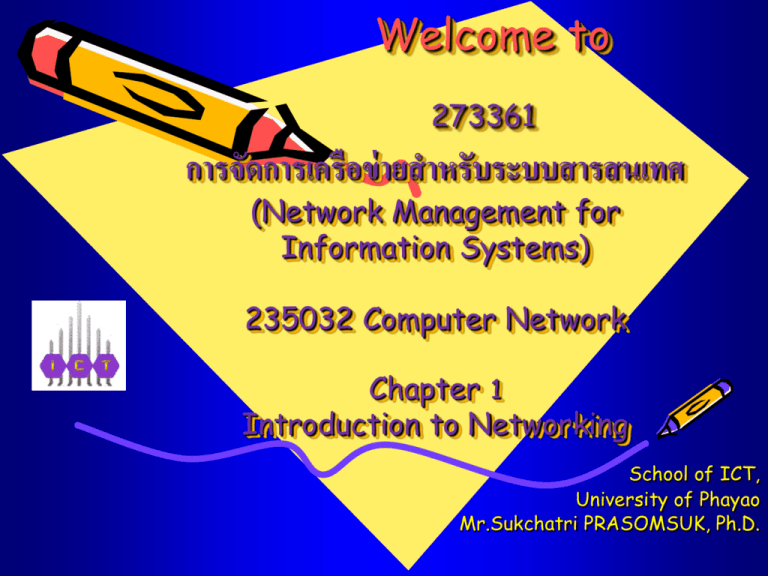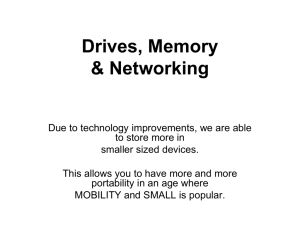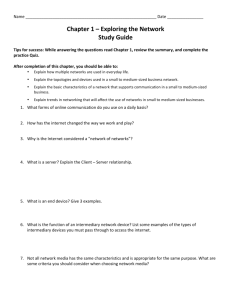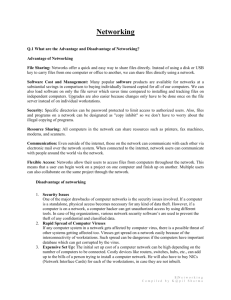Lecture1
advertisement

Welcome to 273361 การจัดการเครื อข่ ายสาหรับระบบสารสนเทศ (Network Management for Information Systems) 235032 Computer Network Chapter 1 Introduction to Networking School of ICT, University of Phayao Mr.Sukchatri PRASOMSUK, Ph.D. About me & Introduce yourself ดร.สุขชาตรี ประสมสุข (Sukchatri PRASOMSUK, Ph.D.) • • • PhD. (Computational Linguistics), INALCO, Paris, FR M.Eng.(IT), & Grad.Dip. In Applied IS, RMIT, Melbourne, AU B.Sc.(คณิตศาสตร์), ม.รามคาแหง • เคยทางานที่ : » DATA SOLVE Co.,Ltd. & Central Trading Co.,Ltd » กรมวิทยาศาสตร์บริการ กระทรวงวิทย์ฯ » ม.หอการค ้า และ ม.แม่ฟ้าหลวง Contact : » skchatri@hotmail.com » 0804509105 • Notes/Slides Download: » http://www.ict.up.ac.th/skchatri/ Network Management for Information systems 2/42 Course Overview Study time : • Class: Mon. ICT 1419 : • LAB : Mon. ICT 1402 : 15.00-17.00 17.00-19.00 Grading : • Atten.& Assignments (Lec.& LAB) • Lab Test 1 • Mid-Term Exam 10 % 30 % 30% • Final-Term Exam 30% Network Management for Information systems 3/42 Course Overview Text: • Data Communications and networking, 2nd Edition, Forouzan, McGrawHill, 2002 • Cisco CCNA • Network A+ Network Management for Information systems 4/42 Scope of Course • Data Communications • LAN (local area networks) • Communications architecture and protocols and wide-area networks (WAN). • Concepts, terminology, principles and design approaches used in data communication systems. • Layered protocol architecture. Network Management for Information systems 5/42 Scope of Course What are data communication systems? • A set of devices (hosts) connected by a communication medium that are able to share data through transmission over the media • System Characteristics include (but are not limited to) – Physical properties of the communication signals Network Management for Information systems 6/42 Data Communication Systems – Physical topology of the communication medium and logical topology of the data transmission – Format and timing of the signals – Error and Flow control, connection management, recovery, security – be able to quickly find protocol descriptions and problem solutions/discussions – be able to discuss data communication systems with supervisors and coworkers on the job Network Management for Information systems 7/42 Introduction – Why do we use data communication systems? • To facilitate the sharing of resources – – – – Printers Disk/Tape drives Computational Power Data Sets • To permit the distribution of workload – Concurrent/parallel computing – Client-server computing – Fault tolerance Network Management for Information systems 8/42 Networks and standardization • Network goals – – – – – – information sharing resource sharing global environment Interconnectivity cost of network equipment, training Microsoft, Novell, Unix Network Management for Information systems 9/42 Network Evolution • Network evolution – Local Area network (LAN), Metropolitan Area Network (MAN), Wide Area Network (WAN) • Local Area network (LAN) – single building – internal data rates are higher – data rates of 10Mbps - 1 Gbps (1Mbps= 106bps) Network Management for Information systems 10/42 Network Evolution • Copper Distributed Data Interface (CDDI) • Fiber Distributed Data Interface (FDDI) • Low speed LANs--Ethernet, token ring, token bus and some Non-OSI LANs • High speed LANs--Switched Ethernet, FDDI, 100 Mbps voice grade, Gigabit Ethernet Network Management for Information systems 11/42 Network Evolution • Metropolitan Area Network (MAN) – metropolitan area, optical; fiber, financial transaction • Wide Area Network (WAN) • Wide area networks – long distance > 800 miles, Govt. agencies own it – Data rates of 1Mbps-100Gbps • • Circuit switching Packet switching Network Management for Information systems 12/42 Network Evolution • Integrated Services Digital Networks(ISDN)->Public telecommunication networks, digital switches and paths, broad range of traffic • Narrowband ISDN --> 64-kbps channel, circuit switching operations • Broadband ISDNs--> 100s of Mbps, packetswitching operation • Frame relay-->high data rates (2 Mbps) and low error rate • Asynchronous Transfer Mode(ATM)-->Cell relay, fixed length, 10s and 100s of Mbps Network Management for Information systems 13/42 Network Evolution • Public analog telephone networks – Private line network • offers a fixed bandwidth • slow speed modem • digital line--56 Kbps-1.544 Mbps – Circuit-switched network • slower data rate – Packet-switched network • X.25--widely used standard protocol • slower and limited to 56 Kbps Network Management for Information systems 14/42 Network Evolution • Public switched data networks – low-speed asynchronous terminal interfaces, X.25 synchronous terminal interface • Value-added networks – communication processors-- nodes, minicomputer--engine Network Management for Information systems 15/42 Components of computer networks • Hardware--telephone lines, – – – – – coaxial cables (1860, 10,800, 13200 voice channels, MOdulation/DEModulation, Coder/decoder, acoustic coupler, line interface, terminals, input/output devices, internetworking devices • Software--user application, – network operating system, – network control module, – line control module, I/O driver, other library functions Network Management for Information systems 16/42 Components of computer networks • Network structure – – – – Interface message processor (IMP) Point-to-point communication Multicast communication Broadcast communication Network Management for Information systems 17/42 Components of computer networks – How do data communication systems work? • Systems communicate over a shared communication medium according to an agreed upon convention (standard). • Several sets of standards currently exist: – – – – TCP/IP OSI model Commercial: SNA, IPX, X.25, ... Proprietary Network Management for Information systems 18/42 LAN evolution • Ethernet-based LANs: 10 Base-2, 10 Base-5, 10 Base1-T, 10 Base-FL, 100 Base-T, 100 Base-FX • Gigabit Ethernet-- high speed packet switching • 100/1000 switches • ATM-- LAN-to WAN migration • LANs--higher data rates for integrated traffic • Virtual LAN-- LAN switching, uses a look up table for routing the frames Network Management for Information systems 19/42 Basic Networking Knowledge • Bus Topology • Star Topology • Ring Topology • Mesh Topology (for WAN) Network Management for Information systems 20/42 Basic Networking Knowledge • Bus Topology : IEEE 802.3 , use a process called Carrier Sense Multiple Access/Collision Detection (CSMA/CD) prevents the occurrence of another collision. Network Management for Information systems 21/42 Basic Networking Knowledge • Star topology : can have a maximum of 1,024 nodes on a LAN and is commonly used for 10BASE-T (IEEE 802.3) and 100BASE-TX (IEEE 802.12) Ethernet Network Management for Information systems 22/42 Basic Networking Knowledge • Ring topology : IEEE 802.5, There is no beginning or end of the cable. This particular topology forms a complete ring. The devices on this network use a transceiver to communicate with their neighbors. Transceivers also act like repeaters to regenerate each signal as it is passed through the device. Network Management for Information systems 23/42 Basic Networking Knowledge • Mesh topology : used for WANs, a mesh topology connects every device on the network together and provides a path to and from each device Network Management for Information systems 24/42 Segments and backbones • Segments : - a trunk (main line) of cabling (concentration device (hubs or switches) - a logical grouping of devices (subnet) by bridges, switches, or routers. - collision and/or broadcast domain Network Management for Information systems 25/42 Segments and backbones • Backbones : -main cable (or trunk) -are the foundations of both LANs and WANs where servers, routers, and concentrating devices (such as switches and hubs) are connected by a high bandwidth connection. Network Management for Information systems 26/42 Network Operating Systems (NOS) • Microsoft Windows NT, 2000 : New Technology File System (NTFS) or File Allocation Table (FAT). • Novell Netware :uses the NetWare Directory Services (NDS). NetWare's primary file system is a combination of FAT (File Allocation Table) and DET (Directory Entry Table). Layer 3 protocols, which are used in this OS are the Internetwork Package Exchange (IPX) protocol and the Internet Protocol (IP). • Unix : key features include multitasking, multi-users, and networking capabilities. Multiple versions of UNIX exist, including Sun Microsystems' Solaris, IBM's AIX, Silicon Graphics' IRIX, Linux, or Hewlett-Packard's HP-UX Network Management for Information systems 27/42 Protocol • IP (Internet protocol) • IPX (Internetwork Packet Exchange) • NetBEUI (NetBIOS Extended User Interface) Network Management for Information systems 28/42 RAID Overview (Redundant Array of Inexpensive Disks) • • • • • Mirroring : RAID 1 : 2 Disk 1 controller Duplexing : RAID 1 : 2 Disk 2 controller Stripping : RAID 2,5 : 3 Disks 1 controller with (no)parity. Volumes : logical structure on the same physical disk Tape Backup : to store data, Quarter Inch Tape (QIC), Digital Audio Tape (DAT), and Digital Linear Tapes (DLT). Network Management for Information systems 29/42 The OSI model Network Management for Information systems 30/42 Cabling Network Management for Information systems 31/42 Cabling Network Management for Information systems 32/42 Cabling Network Management for Information systems 33/42 Cabling Network Management for Information systems 34/42 Ethernet Network Management for Information systems 35/42 LAN Symbol Network Management for Information systems 36/42 WAN & Devices Network Management for Information systems 37/42 IP Addressing Format Network Management for Information systems 38/42 IP Address Component Fields Network Management for Information systems 39/42 IP Address Classes Network Management for Information systems 40/42 IP Address Bit Patterns Network Management for Information systems 41/42 IP Address Classes 0--------126 128------------------------191 192----------------------------------------254 Network Management for Information systems 42/42 Questions : • • • • • IP Address 10.5.15.100 198.168.10,15 191.45.30.10 127.0.0.0 Network Management for Information systems 43/42









